Engine Oil Cooler Hose/Pipe Replacement L35
Removal Procedure
- Remove the lines from the engine oil cooler.
- Raise the vehicle. Support the vehicle with suitable safety stands. Refer to Lifting and Jacking the Vehicle in General Information.
- Remove the bolt from the engine oil cooler lines.
- Remove the lines from the support clip.
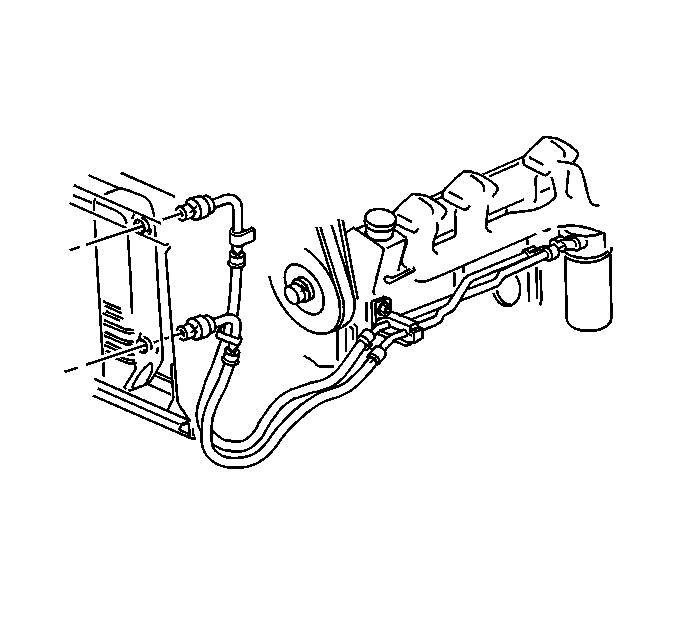
Installation Procedure
- Connect the lines to the support clip.
- Install the bolt to the engine oil cooler lines.
- Lower the vehicle.
- Connect the engine oil cooler lines to the fittings at the oil cooler.

Notice: Use the correct fastener in the correct location. Replacement fasteners must be the correct part number for that application. Fasteners requiring replacement or fasteners requiring the use of thread locking compound or sealant are identified in the service procedure. Do not use paints, lubricants, or corrosion inhibitors on fasteners or fastener joint surfaces unless specified. These coatings affect fastener torque and joint clamping force and may damage the fastener. Use the correct tightening sequence and specifications when installing fasteners in order to avoid damage to parts and systems.
Tighten
Tighten the fittings to 35 N·m (26 lb ft).
Tighten
Tighten the fittings to 24 N·m (18 lb ft).
Engine Oil Cooler Hose/Pipe Replacement L31
Removal Procedure
- Remove the lines from the oil cooler.
- Raise the vehicle. Support the vehicle with suitable safety stands. Refer to Lifting and Jacking the Vehicle in General Information.
- Remove the bolt from the engine oil cooler lines.
- Remove the lines from the support clip.
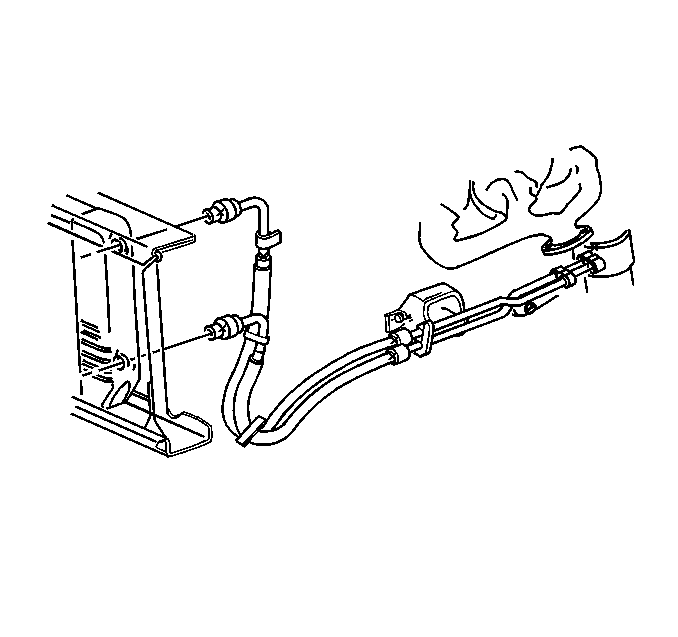
Installation Procedure
- Connect the lines to the support clip.
- Install the bolt in the engine oil cooler lines.
- Lower the vehicle.
- Connect the lines to the fittings at the engine oil cooler.

Notice: Use the correct fastener in the correct location. Replacement fasteners must be the correct part number for that application. Fasteners requiring replacement or fasteners requiring the use of thread locking compound or sealant are identified in the service procedure. Do not use paints, lubricants, or corrosion inhibitors on fasteners or fastener joint surfaces unless specified. These coatings affect fastener torque and joint clamping force and may damage the fastener. Use the correct tightening sequence and specifications when installing fasteners in order to avoid damage to parts and systems.
Tighten
Tighten the bolt to 35 N·m (26 lb ft).
Tighten
Tighten the fittings to 24 N·m (18 lb ft).
Engine Oil Cooler Hose/Pipe Replacement L29
Removal Procedure
- Raise the vehicle. Support the vehicle with suitable safety stands. Refer to Lifting and Jacking the Vehicle in General Information.
- Remove the lines from the auxiliary engine oil cooler.
- Remove the lines from the engine.
- Remove the lines from the support clip.
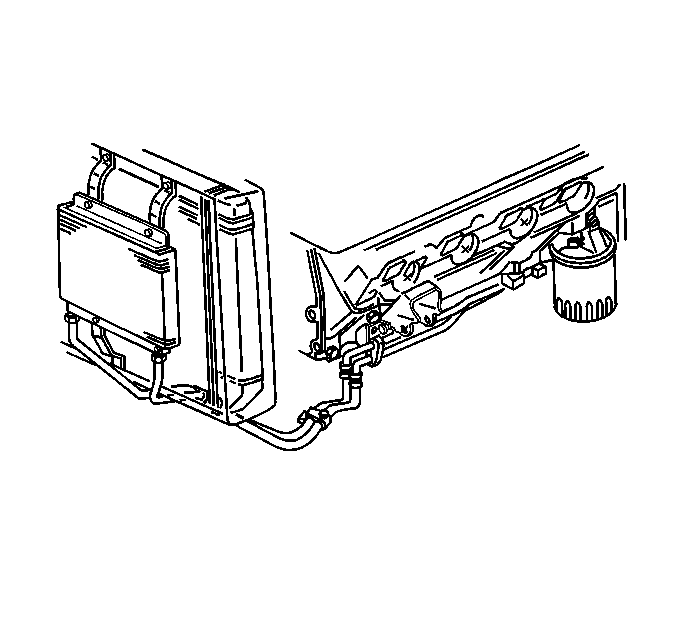
Installation Procedure
- Connect the lines to the support clip.
- Connect the lines to the auxiliary engine oil cooler.
- Connect the lines to the fittings at the engine.
- Lower the vehicle.

Notice: Use the correct fastener in the correct location. Replacement fasteners must be the correct part number for that application. Fasteners requiring replacement or fasteners requiring the use of thread locking compound or sealant are identified in the service procedure. Do not use paints, lubricants, or corrosion inhibitors on fasteners or fastener joint surfaces unless specified. These coatings affect fastener torque and joint clamping force and may damage the fastener. Use the correct tightening sequence and specifications when installing fasteners in order to avoid damage to parts and systems.
Tighten
Tighten the fittings to 7.5 N·m (66 lb in).
Important: You should hear a distinct snap when you assemble the tube fitting to the quick connector if the vehicle is so equipped. Make sure that the tube fitting fully inserts into the quick connector. Check this by giving a forceful pull to the fitting.
Engine Oil Cooler Hose/Pipe Replacement L65
Removal Procedure
- Raise the vehicle. Support the vehicle with suitable safety stands. Refer to Lifting and Jacking the Vehicle in General Information.
- Remove the lines from the auxiliary engine oil cooler.
- Remove the lines from the engine.
- Remove the lines from the support clips.
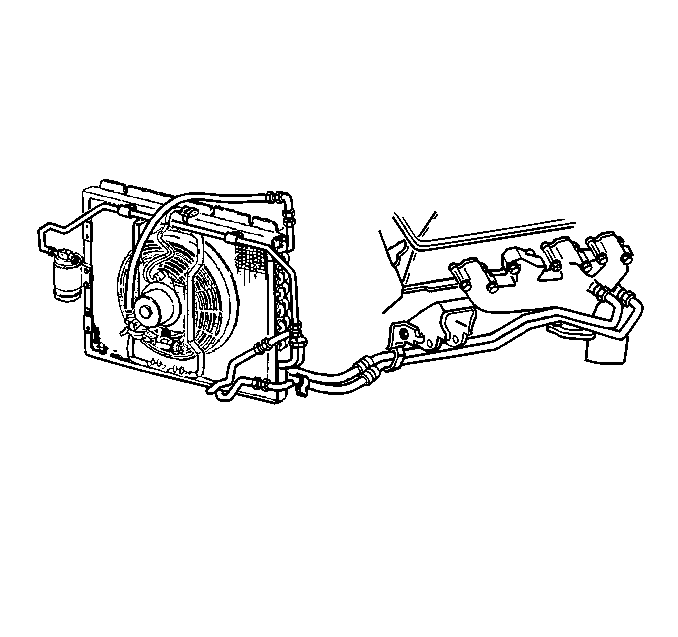
Installation Procedure
- Connect the lines to the support clips.
- Connect the lines to the auxiliary engine oil cooler.
- Connect the lines to the fittings at the engine.
- Lower the vehicle.

Notice: Use the correct fastener in the correct location. Replacement fasteners must be the correct part number for that application. Fasteners requiring replacement or fasteners requiring the use of thread locking compound or sealant are identified in the service procedure. Do not use paints, lubricants, or corrosion inhibitors on fasteners or fastener joint surfaces unless specified. These coatings affect fastener torque and joint clamping force and may damage the fastener. Use the correct tightening sequence and specifications when installing fasteners in order to avoid damage to parts and systems.
Tighten
Tighten the fittings to 7.5 N·m (66 lb in).
Important: You should hear a distinct snap when you assemble the tube fitting to the quick connector if the vehicle is so equipped. Make sure that the tube fitting fully inserts into the quick connector. Check this by giving a forceful pull to the fitting.
Engine Oil Cooler Hose/Pipe Replacement L57
Removal Procedure
- Remove the lines from the engine oil cooler.
- Raise the vehicle. Support the vehicle with suitable safety stands. Refer to Lifting and Jacking the Vehicle in General Information.
- Remove the lines from the fittings at the engine.
- Remove the lines from the support clips.
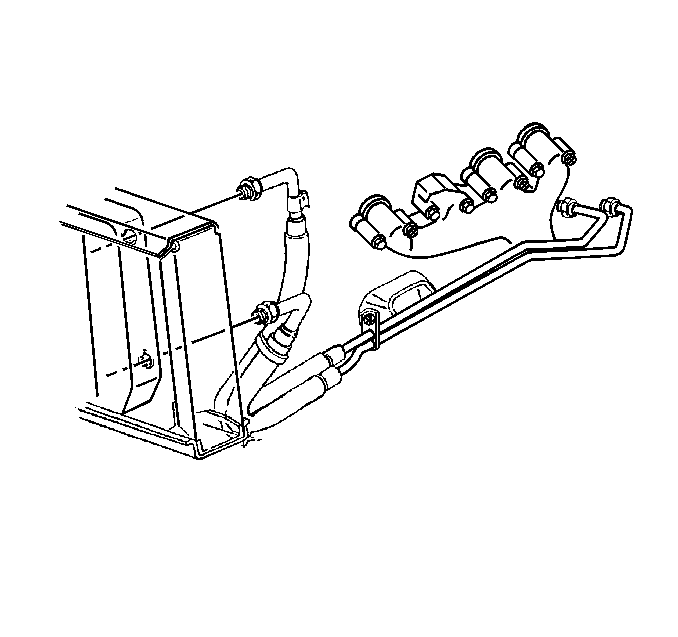
Installation Procedure
- Connect the lines to the support clips.
- Connect the lines to the fittings at the engine.
- Lower the vehicle.
- Connect the lines to the engine oil cooler.

Important: You should hear a distinct snap when you assemble the tube fitting to the quick connector if the vehicle is so equipped. Make sure that the tube fitting fully inserts into the quick connector. Check this by giving a forceful pull to the fitting.
